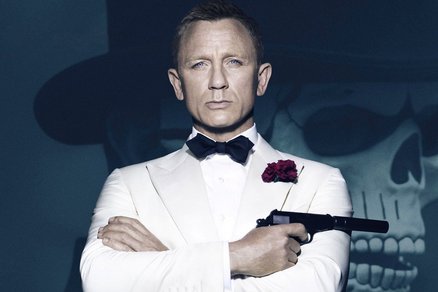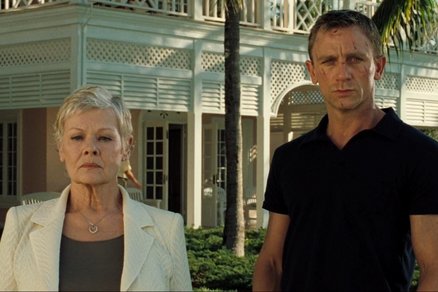
Why did we give No Time to Die (2021) a 12A age rating?
Curriculum links: This case study can be used for those studying 'Component 1: Exploring the Media' on the GCSE WJEC / Eduqas specification.
No Time To Die is the 25th instalment of the long-running franchise about the fictional British MI6 agent, James Bond. Like all the previous Daniel Craig Bond movies, the BBFC issued No Time to Die with a 12A age rating.
In the movie, Bond is forced out of retirement when a new adversary, Russian terrorist, Lyutsifer Safin (Rami Malek), threatens to unleash a deadly biochemical weapon. Bond’s 007 title has been succeeded by another secret agent, Nomi (Lashana Lynch), and the two are reluctantly brought together with the same objective: to save the world from destruction.
As well introducing other new cast members - Billy Magnussen, Ana de Armas, David Dencik and Dali Benssalah - No Time To Die is a first for Phoebe Waller-Bridge who makes her debut Bond co-screenwriting credit, which is also the first instalment of the franchise to be distributed by Universal Pictures. The film also features an Oscar-winning song by Billie Eilish, and received numerous other accolades.

Behind the age rating
Though there is more to James Bond films than violence - a star-studded cast, fast cars, suave costumes, exotic locations and deadpan one-liners - the action sequences are a major selling point for cinema goers. Bond fighting baddies is also a key consideration for the BBFC when it comes to giving the films an appropriate age rating.
No Time To Die was released in cinemas in September 2021 with a 12A age rating, along with the content advice of ‘moderate violence, infrequent strong language’.
A 12A rating is established from the opening of the film - the longest pre-title sequence of any Bond film - in which a young Madeleine Swann witnesses the murder of her mother by Safin. It’s a chilling sequence, particularly when Safin’s laboured breaths are heard below his blank white mask. The focus on domestic threat, which incorporates elements of horror such as a masked killer invading a victim’s home, is somewhat unusual for a Bond film, marking No Time To Die stylistic departure from other outings in the franchise. Indeed, Daniel Craig brings a softness to his Bond; he is arguably more emotional, more vulnerable than previous iterations of the character have been.
Despite the intensity of such scenes, the violence and threat in the film are in keeping with our Classification Guidelines at 12A, which state that violence ‘should not dwell on detail’ and only ‘[o]ccasional blood and injuries may be shown’. The shooting of Mrs Swann largely occurs off-screen, with the camera returning to the action just before Safin stops firing. Later, after Madeleine jumps out of her hiding place and shoots Safin several times in the chest, we see impacts of the bullets hitting his clothing, but blood is limited to the aftermath of the shooting when Madeleine drags Safin’s body through the snow.
The action later switches to the present day; Bond is blasted backwards in a hail of rubble after Vesper’s tomb explodes. He is then pursued by villains on wheels, which requires some skillful footwork. He clashes with a man on a motorbike, engaging him in some hand-to-hand combat. The blows exchanged are crunchy and realistic, and Bond uses a clothing line as an improvised weapon to briefly strangle his enemy before knocking him unconscious. However, blood and injury appear incidental to the action rather than being emphasised during violence.
Bond later comes face-to-face with more baddies while trying to flee with Madeleine, resulting in his Aston Martin taking a battering from heavy gunfire. The DB5 then rolls out in-built gatling guns and some smokescreen, enabling the couple to make a Bond-style escape. This action is impactful, thrilling, and likely to pack a punch on a big screen, but does not go beyond what audiences would expect to see in a 12A rated movie.

In the final act of No Time To Die, after Bond and Nomi have infiltrated Safin’s headquarters, Bond must fight his way up a smoky stairwell. The gunfire is intense, and there are on-screen deaths, but the darkness of the surroundings coupled with the fast pace of the action, hides the stronger details of violence. Bond must then wrestle his way past the same one-eyed enemy he faced earlier, Primo (Dali Benssalah). The implementation of one of Bond’s gadgets, such as his electromagnetic pulse watch, adds a futuristic element to this close-quarters fight and causes Primo’s bionic eye to explode. The funny line from Q about Bond sounding like he’s in a rugby scrum also helps to take the edge off the violence in this scene.
The same dry humour is used earlier in the film, when M (Ralph Fiennes), upon finding out that Q has broken some rules to help Bond access data on their enemy’s targets, says ‘Oh, for f**k sake.’ Strong language such as this requires a 12A age rating.
Industry considerations
Like most films from the James Bond franchise, No Time To Die was first submitted to the BBFC using our Advice service. As part of this process, filmmakers or distributors can get detailed feedback on what age rating their movie is likely to achieve before it is given a formal film classification.
We provide this feedback even in the very early stages of a film’s production: from early concept ideas such as scripts and storyboards, to early rough cuts, or more advanced edits of a film. We will also provide guidance on any changes that may need to be made if our advised rating is not the age rating a filmmaker or distributor was hoping for.
No Time To Die was submitted to the BBFC for Advice largely complete, but with some visual effects missing from a handful of scenes. Unlike other films in the Bond franchise such as Casino Royale or Spectre, we didn’t advise that Universal make any changes; the film was already suitable for their preferred 12A rating.
While we provided Universal with our feedback in February 2020, it was not until September 2021 that No Time To Die was submitted for formal classification due to over a year of Covid-related delays. This meant that Compliance staff at the BBFC had to keep the movie’s bombshell ending under wraps for over a year!

Changing times, changing Bonds, changing standards
Despite No Time To Die’s ending (no spoilers here), James Bond continues to be one of the most iconic film franchises of all time. While these films will continue to be enjoyed by its committed fanbase, the secret agent is likely to appeal to newer and younger generations of viewers as the characters, cast and script adapt to reflect wider developments on-screen in terms of representations of race and gender.
As with changes in representations, come changes to what audiences think. Our age rating decisions are shaped and supported by what people tell us. In our most recent research consultation, we spoke to over 12,000 people across the UK about age rating decisions and various classification issues from U to 18. From this research, we found that some James Bond films would likely receive higher age ratings if they were to be submitted to the BBFC again for classification:
- Goldfinger, the 1964 film starring Sean Connery as Bond, would no longer be acceptable at PG for a scene in which Bond overpowers and kisses Pussy Galore (Honor Blackman) despite her initial resistance and lack of consent.
- From Russia with Love, another Sean Connery instalment, would likely go from PG to 12(A) now because of the strength of the violence in the film.
It is because of our research that we can remain in step with changing societal attitudes, and deliver age ratings that reflect the current views of people in the UK - helping audiences to make informed viewing choices, even on historical titles like those in the James Bond franchise.

Suggested viewing
Casino Royale (Martin Campbell, 2006). 12A
On Her Majesty’s Secret Service (Peter Hunt, 1969). PG
The 355 (Simon Kinberg, 2020). 12A
Discussion points
- There are several references to previous James Bond films in No Time To Die. We call this referencing ‘intertextuality’. What references did you spot?
- Why do you want to make sure the film would receive a 12A rating? What impact do you think this would have on the film’s audience?
- To what extent does the film’s marketing position the film as a ‘legacy’ franchise?


